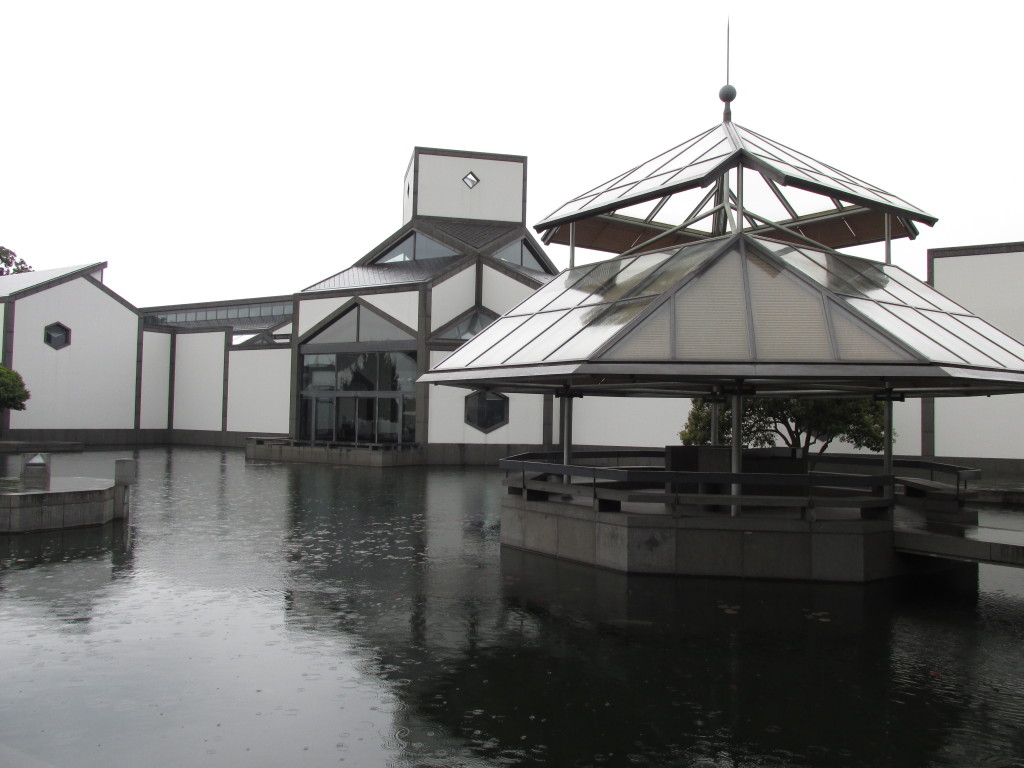When you have visited at least one classical garden (preferably Master of the Nets), you are ready to see what I. M. Pei has done with that traditional form in his design of the Suzhou Museum. Pei, whose work includes the glass pyramid in the courtyard of the Louvre in Paris, returned to his youth both professionally and personally when he accepted Suzhou’s invitation to design the new building. Professionally, he had been trying since his student days to modernize traditional Chinese architecture. Personally, he spent part of his childhood in the home of his uncle, who lived . . . at Lion’s Grove, one of Suzhou’s most notable gardens!
All the elements of a classical garden—latticed windows, corridors, pavilions, the central pond with a bridge crossing it, etc.—can be recognized in Pei’s design of the museum, but they are transformed. You can see this even before you enter. Stand outside the entrance in the walking street. Look past the courtyard and through the glass doors of the museum itself. On the far side of the pond you will see the jagged profile of a mountain range. This is Pei’s substitution for the Taihu rocks that one sees in every classical garden. When you enter the museum, the illusion dissolves and you see instead a staggered line of huge rock slabs, shaped and weathered to produce, like the Taihu rocks, the feeling of being in a vast mountainous wilderness.
The whole museum provides similar delightful variations. Look for the windows, and the views beyond; notice that whereas the pond bridges in the classical gardens are always zig-zagged (to prevent demons from crossing), Pei’s bridge is straight. Notice, too, that while the roof tiles of the classical gardens are gone, the traditional Suzhou color scheme—gray and white—remains. Another stock item remains: goldfish in the pond. Buy some fish food before you go, find a nice spot on the edge of the pond, and watch what happens when you start scattering your offerings: hundreds of gorgeous fish, swarming in a kaleidoscope that will delight you and everyone else. (Be prepared to share your fish food with the kids who will inevitably crowd around to see the fish.)
I usually say that the building itself is the main attraction of the museum, rather than its contents, which despite some wonderful items remain rather modest. However, one friend who came to visit loved the Suzhou Museum because of its modest size. She said it was just big enough to manage, unlike the great museums in London, Paris—or Shanghai—which are impossible to see in a single visit. I love the Buddhist artifacts, and the magnificent ivory tusk carving,* and the royal robes, but there are many other delights, mostly small ones, and I will leave you to discover them for yourself. If you love museums, you could linger for half a day; if not, an hour will do, including the fish-feeding. Either way, you will be glad to have seen I. M. Pei’s brilliant rethinking of the Suzhou classical garden.
To exit the museum you must go out on the east side, past the coffee bar, and through the Taiping Prince’s mansion. The Taiping Rebellion (1850 – 1864) is a fascinating episode in Chinese history. One of the Taiping princes had his digs in Suzhou, and you get to walk through the place. It’s worth some time for its own sake, if you are not too tired, but whatever else you see there, do not leave without finding the private opera stage. Besides being stunning itself, it will help you imagine the traditional setting for Kunqu opera performances, either before or after you have seen one yourself. And if you are one of those Westerners who has been annoyed by the talking, etc., of Chinese people during concerts, or have read such stories, this little stage may help you understand. In the Chinese tradition, people did not come to see the opera; they came to eat, drink, gamble, talk, and see the opera. What would be rude in such a situation would be to ignore the people around you and give all your attention to the stage.
Once you emerge out the front door of the Taiping prince’s mansion, you will find yourself back on the walking street, Dong Bei Jie. If you turn right, you will quickly reach Lindun Lu. If you walk left, you can browse the shops and head toward the Humble Administrator’s Garden, the canal-boat dock, and (a short walk to the south) the Lion’s Grove, where I. M. Pei spent part of his childhood playing in the Taihu rock labyrinth with his cousins.
*No, I do not approve of killing elephants and other animals for their ivory tusks (or for any other reason. Nevertheless, the carving is amazing. Alas, it had been removed the last time I visited the museum.
How to Get There
The Suzhou Museum
苏州博物馆, Su1 zhou1 bo2 wu4 guan3
Take Line 1 on the subway to Lindun Lu, and then take a bus (or three-wheeled bike, if you are feeling touristy) north on Lindun Lu. Buses 2, 178, and 518 all work. Tell the bus driver where you want to go and he (or a helpful fellow passenger) will tell you where to get off. The whitewashed walls of the museum are clearly visible at the northeast corner where 东北街 (dong1 bei3 jie1) crosses Lindun Lu and becomes a pedestrian-only street.



